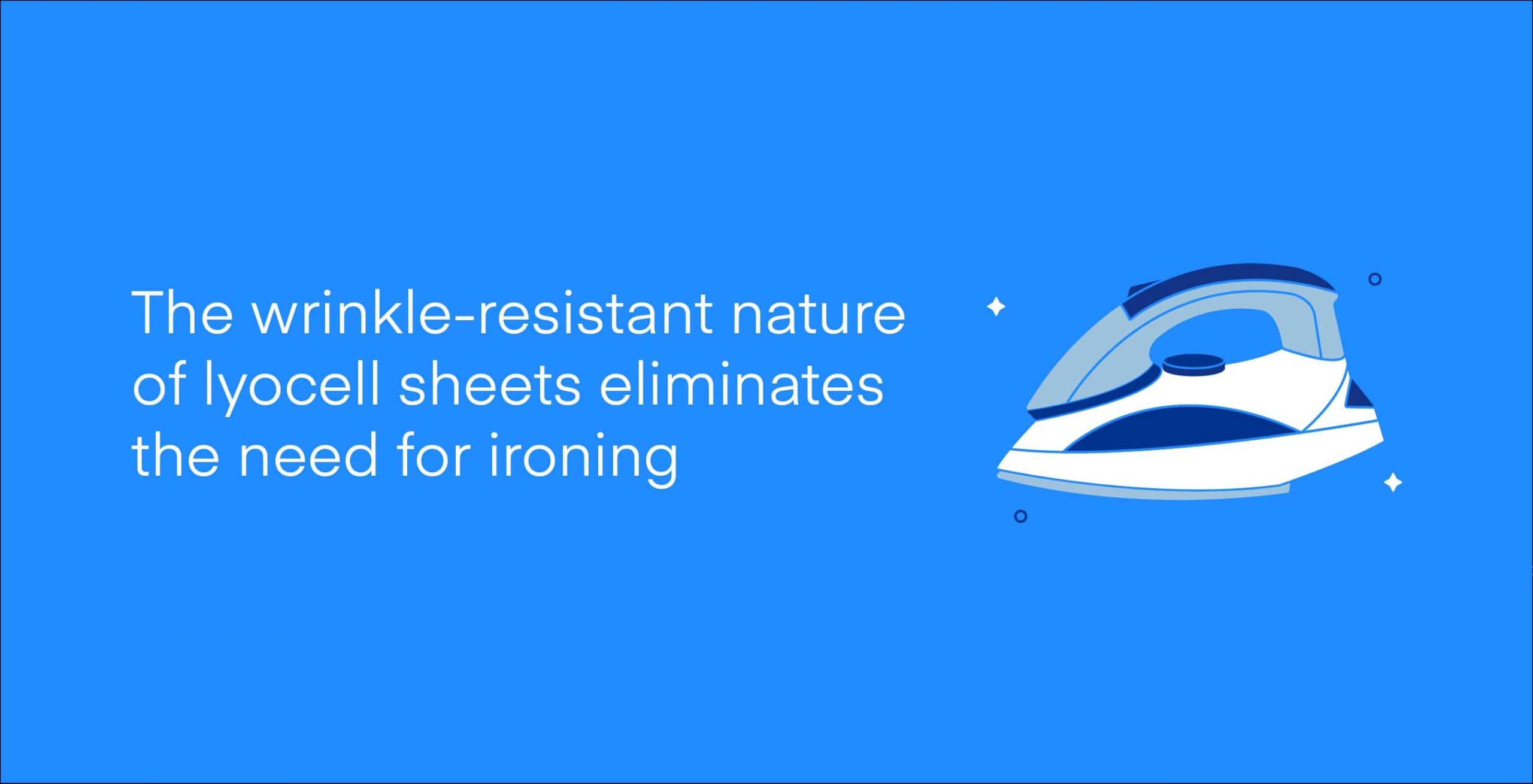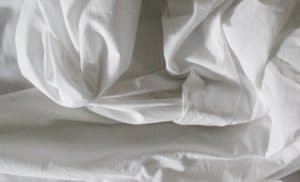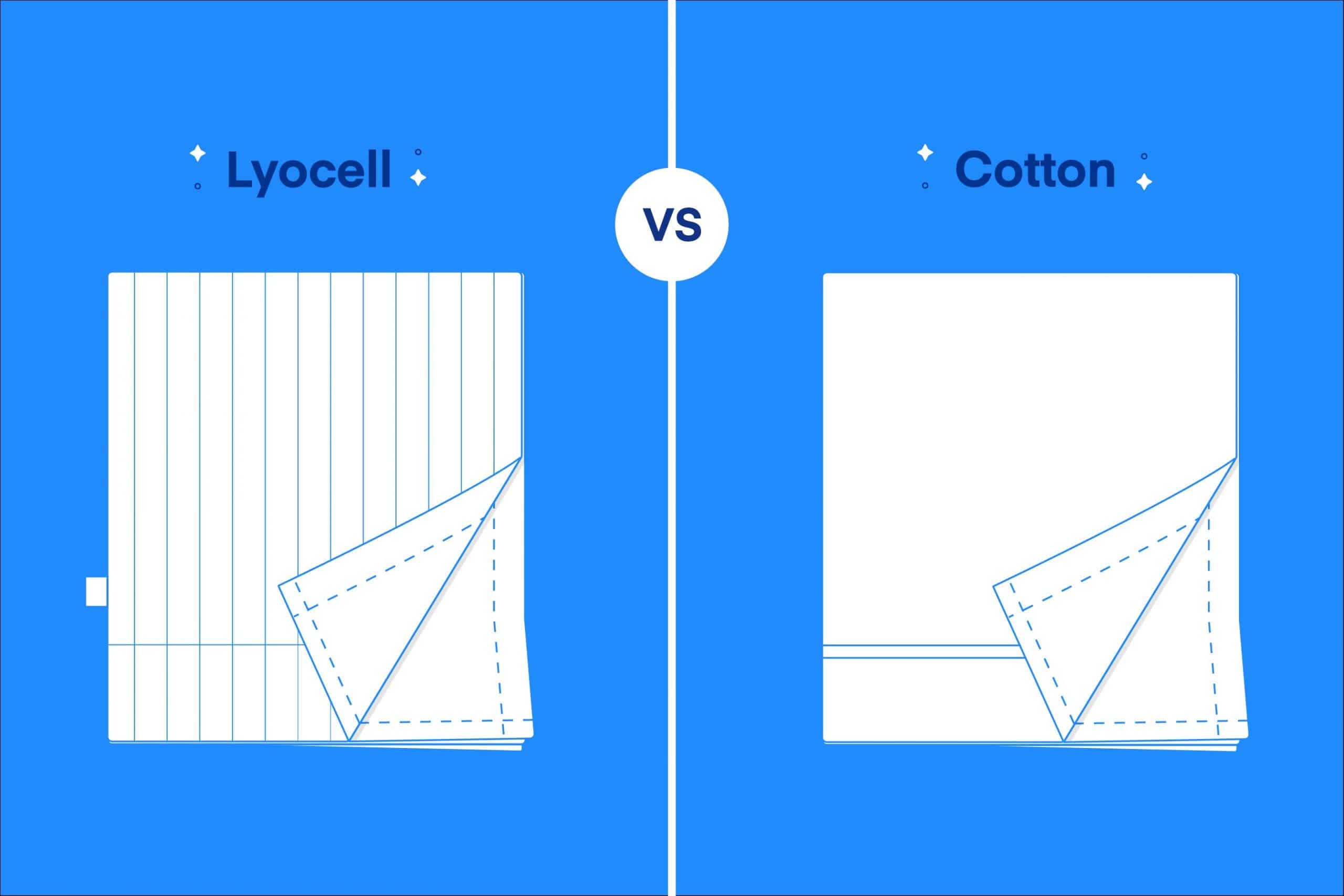The comforting touch of a soft bed sheet is necessary to help you feel relaxed and prepare you for a good night’s sleep. Materials like cotton and lyocell, commonly used to make bed sheets, are both soft and durable with a few key differences.
Choosing bed sheets may be a difficult task. Sometimes you may get carried away by the color or print and not look at the material, weave, and thread count. These important factors determine the feel of bed sheets.
Materials like cotton have been used for thousands of years to make fabric; in fact, it’s the most common bed sheet material. While cotton may be synonymous with comfort, there are other eco-friendly materials like lyocell that are becoming more commonly used in bedding.
What is Lyocell?
Lyocell, commonly known by its brand name Tencel, is a sustainable material and was first developed in 1972. By the late 90s, lyocell started gaining popularity in the bedding industry, but it has still not been able to dethrone cotton as the favorite for bed sheets.
Lyocell comes from the cellulose found in the wood pulp of eucalyptus, birch, or oak trees. It’s manufactured using a “closed-loop process”—almost all the solvents used in the production process get reused and don’t pollute the environment. The solvent chemically breaks down the wood pulp, which is then reformed into fibers, making lyocell a regenerated fiber. Fibrils (small or slender fibers) are isolated from the cellulose-containing source, which are then spun into lyocell nanofibrils—the final product that makes lyocell sheets.
The cellulosic origin and the “closed-loop process” production of lyocell makes it a semi-synthetic, viscose fiber—it is neither a natural fiber like wool, cotton, or silk nor an artificial fiber synthesized out of petrochemicals like nylon or polyester.
What is Cotton?
Cotton is a natural fiber that grows from the seedpod of a cotton plant. The fluffy cotton fiber has been used to make fabric for thousands of years. All cotton fibers are not equal—they are differentiated by the length of their fiber, also known as their staple.
Long-staple cotton is known to be of superior quality with a plush luxurious feel to it, while short-staple cotton does not feel as plush and luxurious because the shorter length of fibers tends to break down faster, spoiling the quality and the feel of the fabric. It also leads to more pilling on the fabric. Long-staple fibers are usually in Egyptian cotton or Pima cotton, which make for plush, durable fabric.
Difference Between Lyocell and Cotton Sheets
While cotton is a natural fiber, lyocell is derived from natural materials and made into fibers through a closed-loop manufacturing process. Both produce top quality bed sheets, which are soft to the touch, but there are certain parameters in which one may be better than the other.
| Parameters | Lyocell | Cotton |
|---|---|---|
| Touch and feel | Feels much softer and smoother from the first day of use | Feels crisp initially, gets softer with use and washing |
| Price | Usually more expensive than cotton | Even the most superior quality of cotton is less expensive than lyocell |
| Durability | Long-lasting and durable, but requires careful handling | Superior quality cotton when woven tight for durability, but requires more washes than lyocell |
| Resistance to pilling | Has better resistance to pilling than cotton | More prone to pilling than lyocell. Inferior quality cotton pills faster |
| Maintenance | Lyocell needs sensitive handling; sometimes it requires hand washing, while other times it may be machine washed on delicate cycle | Cotton is comparatively easy to handle and all varieties of cotton may be machine washed |
| Cooling? | Cool and breathable, and wicks away moisture | Cool and breathable, but cannot wick away moisture |
| Wrinkle-resistant? | Yes | No |
| Eco-friendly? | Yes | Has eco-friendly varieties |
Advantages of Lyocell Sheets
There are many advantages to this silky-soft fabric, which is gradually gaining popularity because of its cooling, hypoallergenic, eco-friendly, and wrinkle-resistance features.
Cooling
Lyocell is a naturally cooling material, and the hydrophilic nature of lyocell fiber makes it super absorbent. Lyocell sheets are very effective at wicking away moisture and keeping you comfortable through the night.
Eco-friendly
Lyocell is manufactured through a closed-loop process, where the chemical solvents used to break down the wood pulp get reused and recycled in every step of the manufacturing process—leaving almost no manufacturing waste.
Lyocell is usually derived from the wood cellulose of eucalyptus trees, which are grown on lands not suitable for cultivation. These lands are not irrigated and the eucalyptus trees are not treated with any chemical fertilizers or pesticides.
Hypoallergenic
Lyocell is a good option for those with sensitive skin because of its hypoallergenic nature. The moisture-wicking ability of lyocell makes for an inhospitable climate for bacteria, viruses, dust mites, and other indoor allergens. Moreover, smooth lyocell fibers have a very plush feel, making lyocell a good option for those with sensitive skin who are prone to develop skin irritation or rashes.
Wrinkle-resistance

Lyocell is produced through nanotechnology which accounts for the material’s super soft texture, making it wrinkle resistant. Nanotechnology ensures that all lyocell fibers are long, which is essential for making the final product soft. The wrinkle-resistant nature of lyocell sheets eliminates the need for ironing after every wash.
Drawbacks of Lyocell Sheets
This eco-friendly, soft material does not have many disadvantages except for higher cost and sensitive handling.
High Cost
The environment-friendly production process of lyocell is expensive. A queen size sheet set may cost around $100 to $300.
Special Care
Though lyocell sheets require less cleaning than cotton, they require careful cleaning. Read the instructions on the care label; some may require handwashing, though you can machine wash them in cold on the delicate cycle with a gentle detergent.
Lyocell shrinks a little after the first wash but then resists shrinkage after. You may air dry or line dry, because tumble drying in a machine may spoil the fibers.
Advantages of Cotton Sheets
Cotton is the most preferred material for bed sheets. This material has been used for ages and has evolved with time. It comes with many advantages like easy maintenance, durability, and it becomes softer with age.
Easy Maintenance
Read the care label for all cotton bed sheets because different varieties of cotton, various weaves, or cotton blended with other materials may require different care—overall it is easy to care for. You may even wash it at high temperatures and tumble dry it on low. However, it is usually recommended to wash Egyptian cotton in cold water so the long fibers are not damaged.
Durable
The long-fibers of Egyptian cotton are strong and make cotton sheets very durable. But not all varieties of cotton are durable. Only Egyptian and Pima cotton are known for their strength.
Gets softer with every wash
Though superior quality cotton is soft and breathable, it may not start that way. New cotton bed sheets usually feel crisp, but with every wash, they get softer.
Drawbacks of Cotton Sheets
Though cotton sheets have many advantages, there are some disadvantages. It’s harder to find high-quality cotton sheets among the thousands of options. Cotton is also prone to wrinkling, and it is not environmentally friendly.
Overwhelming Options
There are many varieties of cotton available on the market, making it difficult to spot superior quality cotton. Egyptian and Pima cotton are known for their long fibers, making them superior quality, but beware of cotton blends, which may not be durable or comfortable.
Easily Wrinkles
The texture of cotton makes it prone to wrinkles. Cotton bed sheets usually need ironing after every wash to smooth creases.
Not Environmentally Friendly
Cotton plants need a large amount of water to grow. Moreover, chemical pesticides may be sprayed on cotton plants to ensure the crops stay healthy and are not damaged by pests, which may negatively impact the environment. However, organically grown cotton may not have chemical pesticides used on it.
Best Cotton Sheet Set: Amerisleep Percale Cotton Sheets
 If you want to go a more traditional route than lyocell, the Amerisleep Percale Cotton sheet set may be for you. These sheets have a crisp, cool feel that will outlast multiple machine washes. They also resist pilling and help wick away heat and moisture to keep you cool and dry all night.
If you want to go a more traditional route than lyocell, the Amerisleep Percale Cotton sheet set may be for you. These sheets have a crisp, cool feel that will outlast multiple machine washes. They also resist pilling and help wick away heat and moisture to keep you cool and dry all night.
These long-fiber cotton sheets boast the long-haul durability of cotton. They’ll get softer with each wash and resist sheets pilling even if you machine wash them. Just make sure to use the gentle cycle to avoid damaging them.
The percale weave also creates a more matte finish and a crisper feel than sateen. In addition, the grid pattern allows for maximum airflow to keep cool air moving around your body. And the cotton absorbs moisture to move it away from you. That means your sheets can help you avoid waking up in a sweat.
Another great feature of these sheets is their deep pockets. Deeper pockets in sheets allow them to wrap further around the mattress and hug it on the underside. This is an extra perk for mattresses under 12 inches thick. But for mattresses over 12 inches thick, it’s a necessity. Without deep pockets, your sheets might pop off the bed on occasion or even every night.
The Amerisleep percale cotton sheets are available in four luxurious colors and come in the standard size run (twin thru split king). They also offer tons of quality at a reasonable price. Expect to pay between $110 and $180, depending on which size you order.
Recommended For:
- Thick mattresses
- Memory foam mattresses
- Hybrid mattresses
Best Features:
- The percale weave promotes tons of circulation for maximum cooling.
- Deep pockets mean your sheets stay firmly in place.
- Long-staple cotton offers increasing softness and unbeatable durability.
Choosing the Right Sheets
Once you have decided on the materials for your bed sheet, you may want to look into other factors such as thread count, weave and color.
Thread Count
Thread count refers to the number of horizontal and vertical threads per square inch. Anything between the range of 300 to 600 is considered an ideal thread count for a good quality bed sheet. General notion is a higher thread count means a more luxurious bed sheet, because more yarns fitting into a square inch space make the sheet more smooth, dense and durable. But this may not always be the case—especially be wary when thread count is higher than 600.
Don’t go blindly by a high thread count, because bed sheet manufacturers have found ways to artificially inflate the thread count by using multiple-ply yarn. To do this, individual inferior-quality threads are twisted around each other. The quality of the thread is most important. While thread count is a parameter in choosing your bed sheet, it is not the only factor that determines your decision-making. Have the average range of thread count in mind when you shop for your next bed sheet.
Weave
There are different kinds of weaves such as percale, sateen, and twill, which add to the texture of your bed sheets. Usually, all lyocell sheets have a sateen weave which lends a silky-soft feel. Cotton bed sheets are usually best in a percale weave because this tight weave adds to the durability of cotton sheets.
Color
Color is a very personal choice. You may choose one depending on the season or the occasion. Light and pastel colors are well suited for summers, whereas rich and earthy colors may be good for the cold winter months.
For example, white sheets have their pros and cons. They offer a pristine look, but tend to yellow with age, requiring you to whiten the sheets to restore their look.
More Types of Sheets
You can go beyond lyocell and cotton sheets when considering what’s most comfortable for your bedroom. Other popular types of sheets include linen, bamboo, microfiber, and more. We have a number of shopping guides comparing and contrasting common sheet materials:
- Bamboo vs. Tencel Sheets: What’s the Difference?
- Bamboo vs. Cotton Sheets: What’s the Difference?
- Cotton vs. Microfiber Sheets: What’s the Difference?
- Tencel vs. Cotton Sheets: What’s the Difference?
- Bamboo vs. Microfiber Sheets: What’s the Difference?
FAQs
What is the best type of cotton for a bed sheet?
Egyptian cotton sheets are considered the best, but there are other varieties like Pima cotton which also make for comfortable bed sheets. Pima cotton generally refers to all extra-long staple (ELS) cotton, grown in the US, Australia, and Peru.
What is the difference between lyocell and Tencel?
Tencel is the brand name for lyocell. Lyocell is a form of rayon, a manufactured fiber made from natural sources. Lyocell is made using cellulose fiber from wood pulp. Lyocell was first developed in 1972 and as a pilot project and was called “Newcell”, later it was commercialized with the brand name Tencel.
Conclusion
Choosing sheets for yourself may not seem like a difficult task initially, but if you want comfortable bed sheets that will last a long time, you may have to do some extra research. Both cotton and lyocell are cool, comfortable, and breathable materials—you have to decide which suits you better depending on the feel and how much you’re willing to maintain them.
About the author
Mitchell Tollsen is a graduate student and a freelance writer who’s contributed to the Early Bird blog for three years. Mitchell’s always been fascinated by the science of sleep and the restorative processes our bodies undergo when at rest. The self-titled “Sleep Expert” is always looking for ways to improve his shut-eye, and throughout the years has implemented numerous lifestyle changes and tried dozens of sleep-promoting gadgets to determine the best ways to truly get better rest.
View all posts





